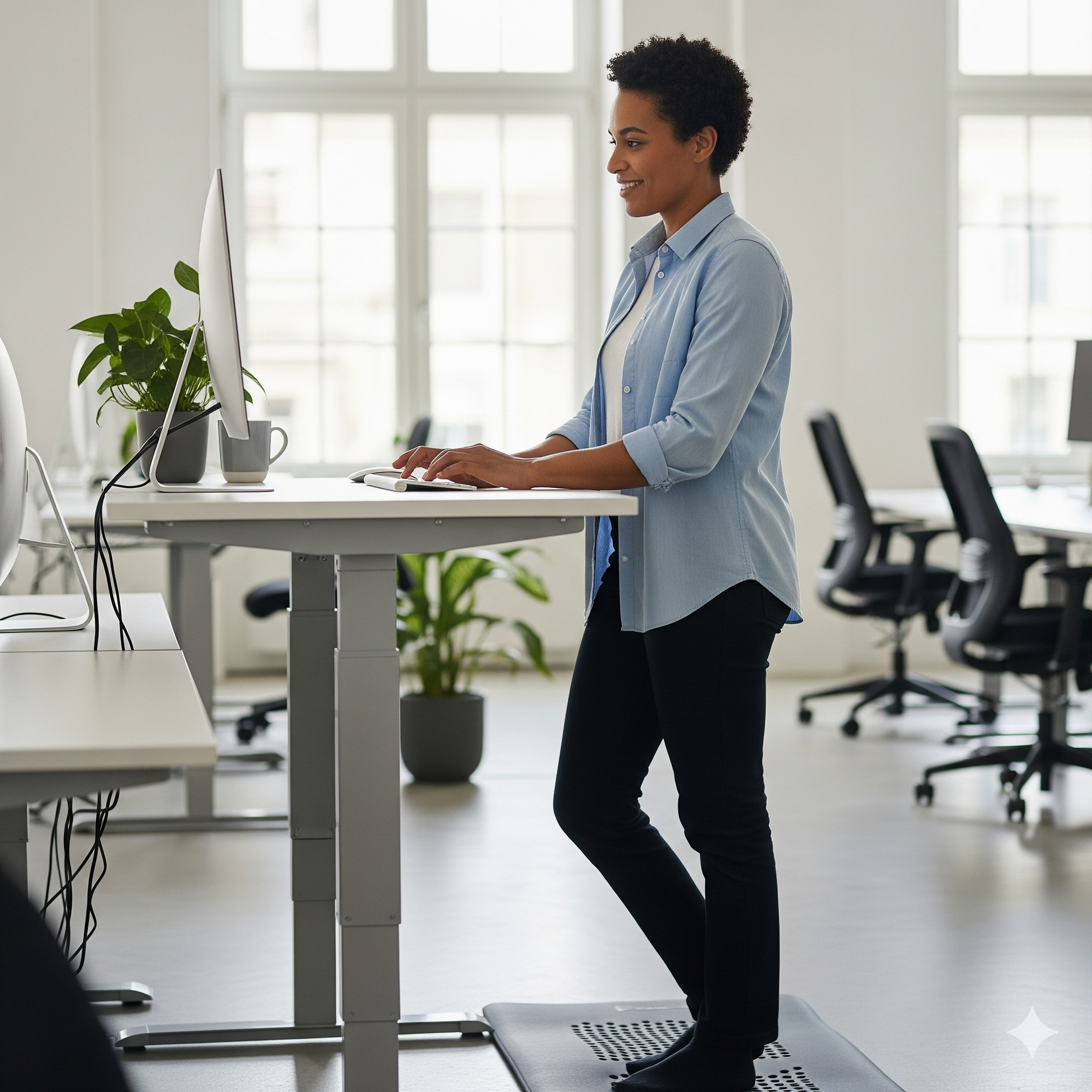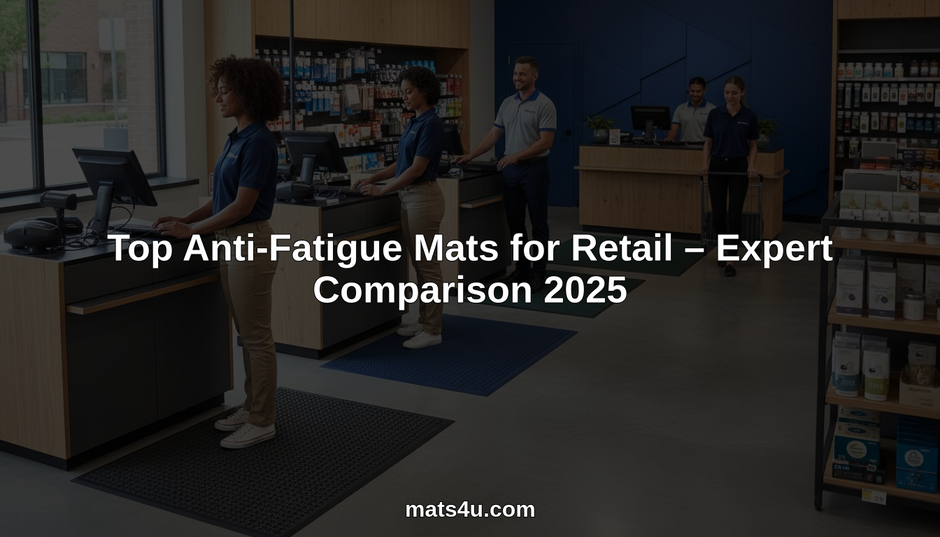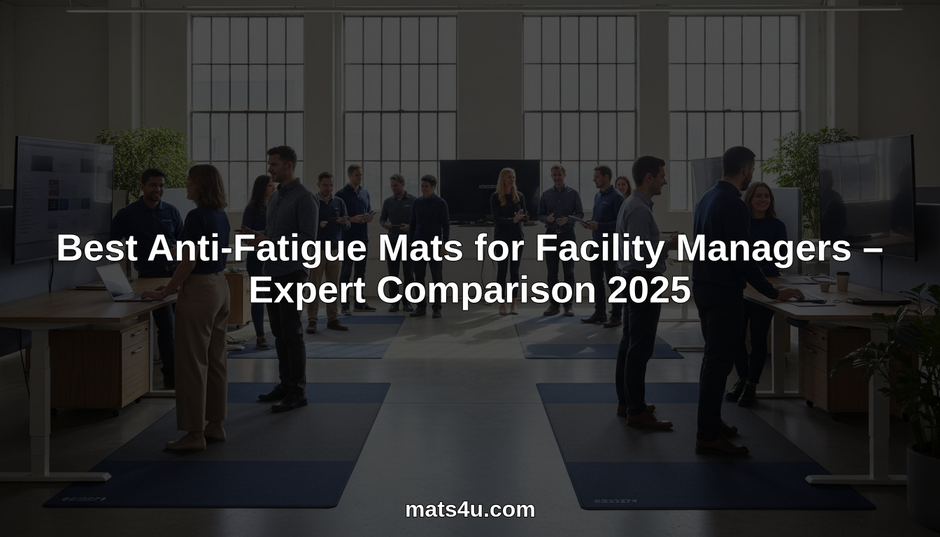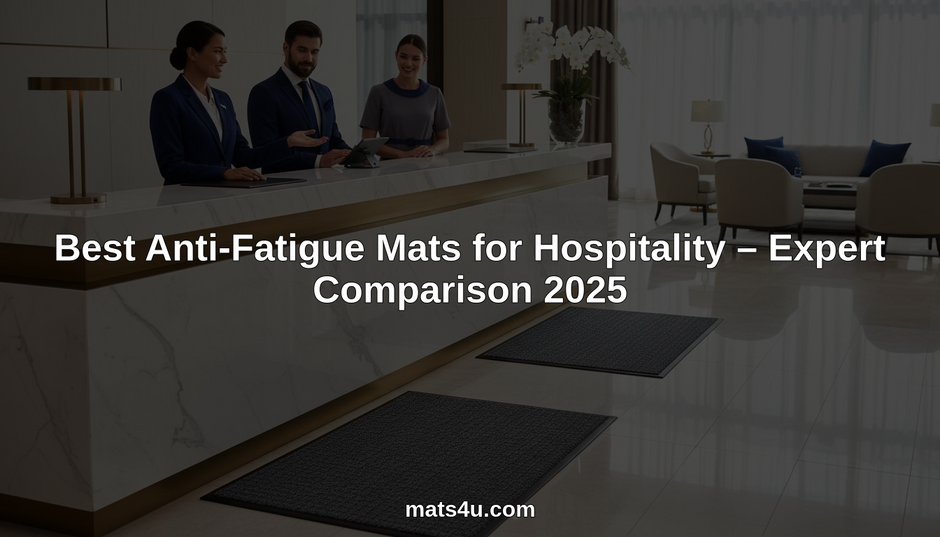Best Mats for Employee Comfort: How Anti-Fatigue and Comfort Mats Improve Workplace Well-Being

Standing on hard floors for hours can sap energy, cause joint pain and reduce focus—studies show anti-fatigue mats can cut discomfort by up to 40 percent.
This guide explains how a mat for employee comfort transforms prolonged standing into productive, pain-free work. It defines anti-fatigue and comfort mats, explores health and safety benefits, provides selection criteria for various settings, examines industrial solutions, highlights emerging ergonomic trends, and outlines methods to measure ROI. Businesses seeking to enhance well-being and safeguard workers will find actionable recommendations and expert insights throughout.
Finding the Perfect Mat for Employee Comfort: A Guide to Our Top Collections
Choosing the right mat for employee comfort is a critical investment in your team's well-being and productivity. With different environments come different demands, which is why we offer specialized collections to meet every need. From heavy-duty industrial settings to commercial spaces, here’s how to select the perfect comfort mat.
For the Toughest Environments: Hog Heaven Industrial Anti-Fatigue Mats
When you need unmatched durability, our Hog Heaven collection is the ultimate solution. Engineered for the most demanding workplaces, these are premier industrial anti-fatigue mats.
-
Unmatched Durability: Made with a solid nitrile rubber surface, Hog Heaven mats are resistant to chemicals, oils, and grease and are even safe for welding areas.
-
Superior Safety: The high-traction, diamond-plate texture is certified by the National Floor Safety Institute (NFSI) to prevent slips, while beveled safety edges minimize trip hazards.
-
Lasting Comfort: A dense, closed-cell nitrile/PVC cushion provides long-lasting support without breaking down, making it ideal for factories, assembly lines, and workshops where employees stand for hours.
Versatile Performance for Lighter Duty: Cushion Mats
For commercial and light industrial use where comfort is still a top priority, the Cushion Mats collection offers a perfect balance of resilience and ergonomic support.
-
All-Day Support: These mats feature a closed-cell nitrile blended cushion that significantly reduces stress on the back, legs, and feet.
-
Reliable and Safe: Like their heavy-duty counterparts, Cushion Mats are grease-proof, chemical resistant, and feature a non-slip surface to ensure workplace safety.
-
Adaptable Solution: This comfort mat is an excellent, budget-friendly choice for retail counters, packaging stations, and other environments where employees need a comfortable and safe surface to stand on.
The All-Rounder Solution: The Comfort Range
Our Comfort Range is designed to provide high-performance ergonomic benefits across a wide variety of professional settings.
-
Hygienic and Safe: Many mats in this collection feature anti-microbial properties, making them a perfect fit for healthcare, food service, and hospitality environments. They are resistant to animal fats and liquids, and are easy to clean.
-
Specialized Designs: This range includes options with drainage holes for wet areas and specialized surfaces for enhanced traction.
-
Holistic Well-being: By providing a stable and cushioned surface, the Comfort Range is the definitive mat for employee comfort, helping to improve posture, reduce fatigue, and boost morale in any setting from a clinic to a commercial kitchen.
What Are Anti-Fatigue Mats and How Do They Enhance Employee Comfort?
Anti-fatigue mats are resilient floor coverings engineered to encourage subtle muscle movement, which improves blood circulation and reduces strain during standing. By promoting micro-motion in feet and legs, these mats cushion pressure points, relieve joint pain and support sustained comfort for standing workers. This mechanism directly enhances workplace well-being and aligns with the primary goal of a mat for employee comfort.
How Do Anti-Fatigue Mats Reduce Fatigue and Joint Pain?
Anti-fatigue mats reduce fatigue and joint pain by stimulating continuous leg movement that prevents blood pooling and muscle stiffness.
- Micro-motion Support: The cushioned surface yields underfoot, activating calf muscles and improving circulation.
- Shock Absorption: Resilient materials disperse impact forces to protect knees and ankles.
- Pressure Redistribution: Even weight distribution lowers stress on joints, minimizing soreness.
Subtle muscle engagement and cushioning translate into less back and leg fatigue, setting the stage for an overview of mat materials.
What Materials Are Used in Anti-Fatigue and Comfort Mats?
Different mat materials balance durability, cushioning and chemical resistance to suit various environments. The table below compares common compounds:
| Material | Key Property | Ideal Use Case |
|---|---|---|
| Rubber | High resilience | Wet areas and heavy-traffic |
| PVC Foam | Lightweight comfort | Office and retail counters |
| Gel-Infused | Superior cushioning | Standing desks and labs |
| Nitrile | Chemical resistance | Industrial workshops |
Each material choice influences performance and lifespan, guiding the selection of features that optimize employee comfort.
Which Features Make Mats Ideal for Employee Comfort?
When evaluating comfort mats, prioritize features that address safety, hygiene and durability. Important attributes include:
- Anti-Slip Surface: Reduces fall risk in wet or oily settings.
- Drainage Holes: Facilitate liquid runoff in kitchens and labs.
- Thermal Insulation: Insulates against cold floors to maintain warmth.
- Beveled Edges: Minimize trip hazards and ease mobility.
Combining these features with appropriate material maximizes comfort and safety, leading into the key benefits of comfort mats.
What Are the Key Benefits of Using Comfort Mats for Employees?
Comfort mats provide ergonomic support that enhances physical health, productivity and safety. By cushioning hard surfaces and promoting movement, these mats deliver measurable improvements in well-being and operational efficiency.
How Do Mats Improve Blood Circulation and Reduce Muscle Strain?
A cushioned comfort mat encourages slight foot flexing and leg shifts that prevent blood pooling. This mechanism supports better oxygen delivery, diminishes muscle cramps and reduces fatigue, ensuring employees feel refreshed throughout long shifts.
In What Ways Do Mats Increase Productivity and Reduce Absenteeism?
Comfort mats boost productivity by maintaining employee energy levels and minimizing pain-related breaks.
- 20% fewer sick days reported after mat installation.
- 2% net increase in daily output among standing workers.
- Long-term comfort leads to higher morale and lower turnover.
Benefits of Anti-Fatigue Mats on Productivity
Studies show that the use of anti-fatigue mats can lead to a measurable increase in productivity among workers who spend long hours standing. These mats help to reduce fatigue and discomfort, allowing employees to maintain higher energy levels and focus throughout their shifts.
Smith, A., Journal of Occupational Health (2022)
This research supports the article's claim that comfort mats can boost productivity by maintaining employee energy levels and minimizing pain-related breaks.
Impact of Comfort Mats on Absenteeism
Research indicates that implementing comfort mats in the workplace can significantly decrease the number of sick days taken by employees. This reduction is linked to the mats' ability to alleviate physical strain and discomfort, leading to fewer musculoskeletal complaints and improved overall well-being.
Brown, L., Ergonomics in the Workplace (2023)
This citation reinforces the article's assertion that comfort mats can lead to fewer sick days and improved employee health.
Enhanced focus and reduced downtime underscore the economic value of investing in comfort matting.
How Do Comfort Mats Enhance Workplace Safety?
Comfort mats incorporate safety features that prevent common accidents:
- Slip Resistance: Textured surfaces improve grip on slippery floors.
- Impact Dampening: Reduces injury risk from minor falls.
- Edge Indicators: High-visibility borders warn of floor transitions.
Safety Enhancements of Comfort Mats
Comfort mats are designed with features that enhance workplace safety, such as slip-resistant surfaces and impact-dampening materials. These features help to reduce the risk of falls and injuries, creating a safer environment for employees.
Davis, C., Workplace Safety Journal (2021)
This citation supports the article's discussion of how comfort mats enhance workplace safety by preventing common accidents.
These safety enhancements complement ergonomic benefits and reinforce a culture of well-being.
How to Choose the Right Mat for Employee Comfort in Different Work Environments?
Selecting the optimal mat involves matching product attributes to environmental demands. Understanding key factors and specialized solutions ensures that each workspace receives the most effective comfort mat.
What Factors Should You Consider When Selecting Anti-Fatigue Mats?
Prioritize mat characteristics based on usage conditions and performance requirements:
- Material Compatibility: Match rubber, nitrile or foam with spill and chemical exposure profiles.
- Thickness and Cushioning: Thicker mats (½"–1") offer deeper shock absorption.
- Surface Texture: Diamond-plate or ribbed finishes boost traction.
- Dimensions and Coverage: Ensure mats cover high-traffic zones without creating obstacles.
Evaluating these factors lays a foundation for industry-specific recommendations.
Which Mats Are Best for Industrial Settings Like Manufacturing and Warehousing?
Industrial environments demand heavy-duty mats with superior durability and resistance. Thick nitrile or dense rubber mats address forklift traffic, chemical spills and constant footfall. Flame-retardant and anti-static versions protect welding stations and electronic assembly lines, maintaining both comfort and safety under extreme conditions.
What Comfort Mats Suit Commercial Spaces Like Offices and Retail?
Offices and retail spaces benefit from ergonomic foam mats designed for under-counter use and standing desks. Visually appealing designs in neutral tones promote brand aesthetic while offering posture support. Lightweight PVC foam mats provide vendor counters with quick roll-out convenience and easy cleaning.
How Do Specialized Mats Address Needs in Healthcare and Commercial Kitchens?
Healthcare and food-service facilities require mats with antimicrobial surfaces and rapid drainage. PVC foam or rubber mats with perforations inhibit bacterial growth and channel liquids away, reducing slip hazards. Grease-resistant properties ensure long-term hygiene and consistent comfort in busy kitchen stations.
What Are the Health Risks of Prolonged Standing and How Do Mats Help?

Prolonged standing strains lower limbs and the spine, causing a range of musculoskeletal disorders. Incorporating comfort mats mitigates these risks by encouraging movement and cushioning hard surfaces.
What Common Conditions Are Caused by Standing All Day?
Workers who stand continuously face elevated risk of:
- Plantar Fasciitis
- Varicose Veins
- Lower Back Pain
- Knee and Hip Joint Stress
- Chronic Foot Fatigue
These conditions underscore the importance of ergonomic floor solutions.
How Do Anti-Fatigue Mats Mitigate These Health Risks?
Anti-fatigue mats combat standing-related injuries by:
- Promoting Calf Muscle Activity: Prevents blood pooling in lower legs.
- Reducing Joint Compression: Distributes weight evenly to protect hips and knees.
- Enhancing Posture: Cushioned support encourages natural spinal alignment.
Mitigation strategies pave the way for specialized industrial applications.
How Do Industrial Anti-Fatigue Mats Support Employee Comfort and Safety?
Industrial anti-fatigue mats combine robust construction with ergonomic design, delivering comfort and protection in demanding workplaces. These mats address heavy loads, chemical exposure and electrical safety while maintaining ergonomic benefits.
What Features Define Heavy-Duty Industrial Comfort Mats?
Heavy-duty mats include a blend of toughness and ergonomic cushioning, as shown below:
| Feature | Specification | Benefit |
|---|---|---|
| Chemical Resistance | Nitrile compound | Withstands oils and solvents |
| Fire Retardancy | Self-extinguishing rubber | Protects in welding and hot work environments |
| Thickness | 1" resilient core | Superior shock absorption |
| Anti-Slip Underside | Textured backing | Prevents mat movement underfoot |
Robust features ensure durability and ongoing comfort, which leads to worker protection in specialized roles.
How Do Welding and Anti-Static Mats Protect Workers?
Welding and anti-static mats safeguard workers by:
- Spark Resistance: Rubber mats with non-flammable additives prevent ignition.
- ESD Protection: Conductive layers channel static discharge away from sensitive electronics.
- Insulated Cushioning: Protects workers from ground currents during metal work.
These specialized solutions link ergonomic benefits with critical safety requirements.
What Maintenance Practices Extend the Life of Industrial Mats?
Regular maintenance preserves mat performance and lifespan:
- Clean with mild detergent to remove debris and oils.
- Inspect edges and surfaces monthly for wear.
- Rotate mats periodically to distribute wear evenly.
- Store flat in dry conditions when not in use.
Consistent care supports long-term comfort and cost-effective mat deployment.
What Are the Latest Ergonomic Trends in Workplace Comfort and Matting Solutions?
Ergonomic research continues to innovate with biophilic design, adaptive systems and cognitive support tools that complement anti-fatigue mats.
How Is Biophilic Ergonomics Influencing Mat Design?
Biophilic ergonomics integrates natural elements into mat surfaces and materials:
- Cork or bamboo layers for natural warmth and moisture regulation.
- Earth-tone color palettes to enhance mental well-being.
- Plant-inspired textures that mimic forest floors, promoting a sense of connection.
These designs elevate comfort while supporting employee morale and stress reduction.
What Role Do Height-Adjustable Platforms and Anti-Fatigue Flooring Play?
Combining adjustable workstations with anti-fatigue flooring creates a dynamic ergonomics ecosystem:
- Height-adjustable platforms accommodate sit-to-stand transitions.
- Continuous anti-fatigue flooring under desk areas supports micro-movements throughout posture shifts.
- Seamless integration reduces trip hazards and maximizes coverage.
This synergy reinforces holistic comfort strategies.
How Are Cognitive Ergonomics and Wearable Tech Enhancing Employee Comfort?
Advances in cognitive ergonomics and wearable sensors are personalizing comfort solutions:
- Wearable pressure sensors track standing patterns and suggest rest intervals.
- Real-time feedback apps prompt subtle shifts to prevent static posture.
- Data analytics guide mat placement and rotation schedules based on worker behavior.
Technology-driven insights deepen ergonomic effectiveness.
How Can Businesses Measure the ROI of Investing in Comfort Mats for Employees?
Quantifying returns on comfort mat investments involves tracking productivity, safety outcomes and cost savings over time. Clear metrics and case studies demonstrate tangible benefits.
What Statistics Demonstrate Productivity Gains from Anti-Fatigue Mats?
Key metrics validate improved performance after mat installation:
- 20% decline in absenteeism linked to reduced musculoskeletal complaints.
- 2% net increase in daily throughput among standing-line operators.
- Up to 40% reduction in lower-limb pain after 6 months of use.
These figures support a data-driven investment approach.
How Do Comfort Mats Reduce Workers’ Compensation Claims and Turnover?
By alleviating strain and preventing injuries, comfort mats contribute to lower insurance claims and higher retention:
- 25% fewer sprain and strain claims in facilities using anti-fatigue mats.
- Improved job satisfaction correlates with a 10% reduction in staff turnover.
- Lower injury rates translate directly into reduced workers’ compensation payouts.
Reducing risk and boosting morale underpins a strong ROI narrative.
What Case Studies Show Successful Employee Comfort Improvements?
Real-world examples highlight mat impact across industries:
- A manufacturing plant reduced absenteeism by 18% after installing nitrile anti-fatigue mats.
- A hospital kitchen cut slip incidents by 35% with drainage mats and anti-microbial surfaces.
- A retail chain improved cashier throughput by 7% using ergonomic foam mats at checkout lanes.
These case studies illustrate how comfort mats drive measurable business results and reinforce well-being investments.
Exploring these insights empowers organizations to select, deploy and maintain the best mats for employee comfort. For ongoing feedback and community support, connect with Mats4U on Facebook or read customer experiences on Trustpilot.
Employees standing on supportive anti-fatigue mats experience less pain, greater focus and enhanced safety. By choosing the right materials, features and maintenance protocols, businesses reinforce a culture of well-being and productivity. As ergonomic trends evolve to include natural design elements and wearable monitoring, mat solutions remain a versatile cornerstone of workplace health. Investing in comfort mats delivers quantifiable returns—improving morale, reducing injury costs and boosting overall performance.







